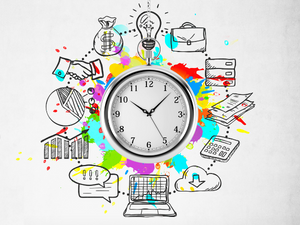 As a business owner or manager, you're likely always on the lookout for innovative strategies to boost productivity and engagement. Gamification has emerged as a powerful tool, not just for customer interaction but also for enhancing employee training and motivation. This blog post explores the benefits of gamification in employee training, providing valuable insights for decision-makers looking to improve their company’s growth and efficiency.
As a business owner or manager, you're likely always on the lookout for innovative strategies to boost productivity and engagement. Gamification has emerged as a powerful tool, not just for customer interaction but also for enhancing employee training and motivation. This blog post explores the benefits of gamification in employee training, providing valuable insights for decision-makers looking to improve their company’s growth and efficiency.
Top FAQ Questions About Gamification
-
How does gamification improve employee training and engagement?
-
What are the key benefits of implementing gamification in a business setting?
What is Gamification?
Gamification involves incorporating game-design elements such as point systems, leaderboards, and badges into non-game contexts to increase engagement, participation, and motivation. By making tasks fun and competitive, gamification encourages employees to perform better and stay committed to their roles.
How Gamification Works
Gamification taps into the intrinsic motivations that drive gamers. Just like in games where players strive to achieve high scores and complete levels, employees can be motivated to excel in their tasks when similar elements are introduced in the workplace. This approach can transform mundane tasks into exciting challenges, leading to higher engagement and productivity.
Improving Learning and Development During Training
Traditional training methods often involve reading extensive documents and watching numerous slides, which can be monotonous and difficult to retain. Gamification revolutionizes this process by making learning interactive and engaging.
Interactive Training
- Hands-On Experience: Gamified training introduces interactive educational games that immerse employees in a game-like environment, making learning more engaging.
- Enhanced Retention: Employees are more likely to retain information through practical, hands-on activities that simulate real-world scenarios.
Real-World Applications
- Simulated Scenarios: Gamified training can simulate real-life situations, allowing employees to practice their skills in a risk-free environment.
- Skill Development: This approach helps employees develop critical skills such as problem-solving and critical thinking, which are essential for handling real-world challenges.
 Developing New Skills and Understanding Real-World Situations
Developing New Skills and Understanding Real-World Situations
Gamification does more than just make training fun; it equips employees with practical skills and a better understanding of their roles.
Real-World Skill Application
- Practical Challenges: Employees test their knowledge and skills in simulated environments, preparing them for real-world tasks.
- Risk-Free Learning: By experimenting without fear of real-world consequences, employees can take risks, learn from their mistakes, and apply these lessons to their jobs.
Increasing Employee Productivity and Performance
Even after the initial training, gamification can keep employees engaged and motivated through various rewards and recognition systems.
Motivation Through Competition
- Leaderboards and Point Systems: Implementing these elements motivates employees to set goals and strive for higher performance.
- Recognition and Rewards: Badges and other rewards can create a sense of achievement and encourage continuous improvement.
 Measuring Engagement and Performance
Measuring Engagement and Performance
- Tracking Progress: Gamification allows employers to track engagement levels and performance metrics, identifying both high achievers and those needing additional support.
- Feedback Mechanisms: Regular pulse surveys can provide focused feedback, ensuring that gamification strategies are effective and aligned with employee needs.
Implementing Gamification in Your Business
Incorporating gamification into your business requires thoughtful planning and execution. Here’s how you can get started:
Steps to Implement Gamification
- Identify Goals: Define what you want to achieve with gamification, such as increased productivity, better training outcomes, or higher employee engagement.
- Choose the Right Tools: Select gamification software and tools that align with your business needs and can integrate seamlessly with your existing systems.
- Design Engaging Content: Develop engaging and relevant game-like elements that resonate with your employees.
- Monitor and Adjust: Continuously monitor the effectiveness of your gamification strategy and make adjustments based on employee feedback and performance data.
Let's Recap
Gamification is a powerful strategy that can significantly enhance employee training and engagement. By making learning interactive, developing critical skills, and increasing productivity through competition and rewards, gamification offers a comprehensive approach to improving business outcomes. For business owners, CEOs, and decision-makers, understanding and implementing gamification can lead to a more motivated, skilled, and engaged workforce.
FAQs Answered
How does gamification improve employee training and engagement?
Gamification improves employee training by making learning interactive and engaging, leading to better retention and skill development. It also boosts engagement by introducing competitive elements and rewards that motivate employees to perform better.
What are the key benefits of implementing gamification in a business setting?
The key benefits include enhanced training effectiveness, increased employee motivation and productivity, and better measurement of engagement and performance. Gamification helps create a more dynamic and rewarding work environment, driving overall business growth.
4o
